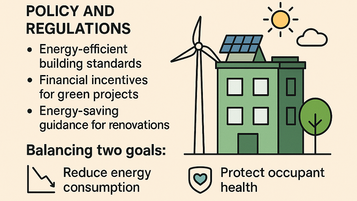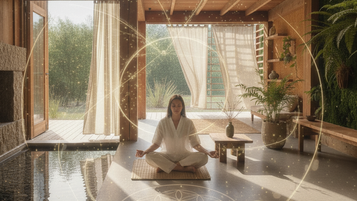Passive Design is not merely a collection of techniques or technologies —
it is a philosophy of living, a way of rethinking the relationship between humans and nature.
It is built upon simple yet profound principles:
- Work with nature, not against it.
- Use energy where and when needed — and only as much as necessary.
- Harness light, wind, earth, water, and local materials.
- Reduce dependence on machines; enhance natural self-regulation.
- Place human health and well-being at the center of design.
“Passive architecture is a way for humans to return to the natural rhythm of the Earth.”

1. The Connection Between Design and Life
A house is not merely a shelter — it is:
• A space that nurtures both physical and mental health.
• A place where people feel safe, relaxed, and connected.
• A reflection of harmony between humans, nature, and materials.
Passive Design helps every home become a part of a living ecosystem,
not just a concrete box isolated from its environment.
2. Impact on the Planet
Housing consumes over 40% of global energy and emits one-third of the world’s CO₂.
Therefore, every design decision — no matter how small — shapes our future.
• A window oriented toward the right direction,
• A line of trees in front of the house,
• A good insulation layer,
• A small solar system —
→ All of these help reduce the burden on our planet.
“If millions of homes breathe with nature, the Earth will heal.”
3. The Role of Technology and Simulation

- Energy simulation allows us to visualize what the eyes cannot see — heat flow, wind movement, light, and humidity.
- Sensors, artificial intelligence, and energy data now enable buildings to respond to weather and human habits.
- Yet, technology is merely a tool — what truly matters is a conscious, responsible, and nature-respecting design mindset.
4. Toward the Architecture of the Future
The future of architecture lies in the harmony between:
• Passive Design: reducing energy demand.
• Active Systems: generating clean energy.
• Renewable and eco-friendly materials: sustainable and low-emission.
• Human-centered spaces: nurturing health, spirit, and community.
• Data- and nature-driven design: intelligent yet emotional.
“The home of the future not only saves energy — it heals both people and the planet.”
5. Change Begins with Each Person
You don’t have to be an architect to make a difference.
Simply:
• Plant more trees around your home,
• Turn off the lights when not in use,
• Open windows to welcome the wind,
• Choose natural materials,
• Opt for energy-saving solutions…
→ Each small action becomes powerful when done with mindful awareness.
6. Reconnecting with Nature
Ultimately, passive architecture is not only about energy —
it’s about harmony: between humans and environment, technology and nature, comfort and simplicity.
“A beautiful home is where you feel at peace — whether in rain or shine, heat or cold.”
7. Overall Conclusion
Passive Design is:
• A path toward genuine sustainability,
• An answer to the energy and climate crises,
• A way for humans to regain balance with the Earth.
The home of the future is not distant —
It begins today, when each of us chooses to live slower, deeper, and in harmony with nature.
“Sustainable design begins from within — from knowing what is enough, and loving the Earth as our true home.”
Tags
Related news

10 Innovative Ways to Use IAQ Data for Healthy Buildings
Closing the Gap Between Data and Action For forward-thinking organizations, improving Indoor Air Quality (IAQ) is a strategic priority. IAQ...
View detail
Designing the Mindful Home: From Matter to Energy
A mindful home is not merely a place to live — it is a conscious space, where every line, material,...
View detail
Body – Mind – Qi: The Foundation of Healing Architecture
The home is not only a shelter for the body but also a space that nurtures the soul and life...
View detail





